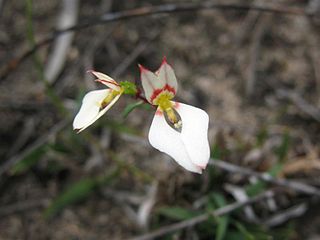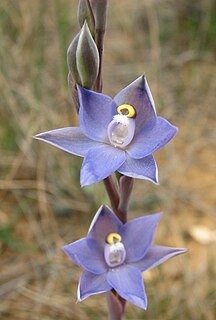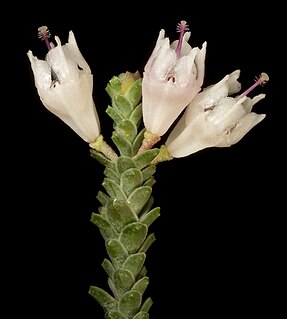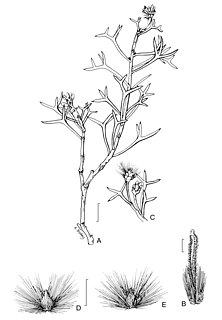
Eucalyptus pauciflora, commonly known as snow gum, cabbage gum or white sally, is a species of tree or mallee that is native to eastern Australia. It has smooth bark, lance-shaped to elliptical leaves, flower buds in clusters of between seven and fifteen, white flowers and cup-shaped, conical or hemispherical fruit. It is widespread and locally common in woodland in cold sites above 700 m (2,300 ft) altitude.

Torreya State Park is a 13,735 acre (56 km²) Florida State Park, United States National Natural Landmark and historic site thirteen miles (19 km) north of Bristol. It is located north of S.R 12 on the Apalachicola River, in northwestern Florida, at 2576 N.W. Torreya Park Road.

Astrantia is a genus of herbaceous plants in the family Apiaceae, endemic to Central, Eastern and Southern Europe and the Caucasus. There are several species, which have aromatic roots, palmate leaves, and decorative flowers. They are commonly known as great masterwort or masterwort which may also refer to other plants, particularly the unrelated Peucedanum ostruthium.

Croomia is a genus of primitive angiosperm herbs in the Stemonaceae family, first described as a genus in 1840.

Primula pauciflora, the pretty shooting star, few-flowered shooting star, dark throat shooting star or prairie shooting star, is a species of flowering plant in the primula family Primulaceae. It is a widespread and very variable species, native to western North America, from Subarctic America to Mexico, often in xeric and desert habitats. It is found in the Great Basin Deserts and Mojave Desert. Its synonyms include Dodecatheon pauciflorum and Dodecatheon pulchellum.

Levenhookia pauciflora, the deceptive stylewort, is a dicotyledonous plant that belongs to the genus Levenhookia. It is an ephemeral annual that grows from 5–10 centimetres (2.0–3.9 in) tall with ovate to suborbicular leaves. Flowers are white and bloom from September to November in its native range. L. pauciflora is endemic to Western Australia where it grows in sandy soils in sandstone or granitic areas. The flowers of L. pauciflora resemble those of Stylidium ecorne and it has been said that S. ecorne mimics L. pauciflora to take advantage of its pollinators.

Dicentra pauciflora is a species of flowering plant in Dicentra, the genus containing the bleeding-hearts. Its common names include shorthorn steer's head and few-flowered bleeding-heart. This perennial wildflower is native to the US states of Oregon and California, where it grows high in the mountains in gravelly soils. This is a short bleeding-heart, approaching 10 centimeters in maximum height. From a rhizome beneath the soil it extends several erect petioles, each holding a leaf divided into leaflets which are each divided into smooth, fingerlike lobes. It also erects a thin stem which is topped with an inflorescence of one to three nodding flowers. Each flower is a shade of pink or purple to white, with two curving outer petals flexed back against the flower, and inner petals extended straight outward. The fruit is a capsule just over a centimeter long. The specific epithet pauciflora, refers to the Latin term for 'few flowered'.

Frankenia pauciflora, the common sea-heath or southern sea-heath, is an evergreen shrub native to southern Australia. It is part of the Frankenia genus of the Frankeniaceae family.

Thelymitra pauciflora, commonly called the slender sun orchid in Australia and maikaika or maika in New Zealand is a species of orchid in the family Orchidaceae. It is one of the most widespread and common orchid species in Australia, growing in all states except Western Australia and the Northern Territory, and also in New Zealand including Chatham Island.
Calycadenia pauciflora is a species of flowering plant in the family Asteraceae known by the common name smallflower western rosinweed. It is endemic to northern California, where it grows in the Coast Ranges north of the San Francisco Bay Area from Napa County to Tehama County.
Salvia pauciflora is a perennial plant that is native to Yunnan province in China, growing in and around forests at 2,800 to 3,400 m elevation. It grows on 2–4 slender unbranched stems with widely spaced leaves. The leaves are broadly ovate to ovate-triangular, typically ranging in size from 2.5 to 6 cm long and 1.2 to 5 cm wide.
Packera pauciflora is a species of flowering plant in the aster family known by the common name alpine groundsel. It is native to northern North America, where it can be found in parts of western and eastern Canada and the northwestern United States. It grows in subalpine and alpine climates, such as mountain meadows.

Stephanomeria pauciflora is a species of flowering plant in the aster family known by the common names brownplume wirelettuce, few-flowered wirelettuce, and prairie skeletonplant. It is native to the southwestern United States and northern Mexico, where it grows in many types of habitat, including many desert areas, woodlands, and plains. It is a perennial herb or bushy subshrub producing one or more sturdy, stiff stems with many spreading branches, taking a rounded but vertical form. The leaves are mostly basal and ephemeral, with smaller, scale-like leaves occurring on the upper stem. Flower heads occur at intervals along the mostly naked stems, especially near the tips. Each has a cylindrical base covered in hairless phyllaries. It contains 3 to 6 florets, each with an elongated tube and a flat pink ligule. The fruit is an achene tipped with a spreading cluster of plumelike pappus bristles. These are usually brownish, but are sometimes white. The specific epithet pauciflora, refers to the Latin term for 'few flowered'.
Tabernaemontana pauciflora is a species of plant in the family Apocynaceae.
Gagea pauciflora is an Asian species of plants in the lily family. It is native to Mongolia, Russia, and China.

Valeriana pauciflora, commonly called the largeflower valerian, is a plant species in the Caprifoliaceae. It is native to the Eastern United States, where it is found in the regions of the Interior Low Plateau, the Ohio River drainage, and the Potomac River Valley. In this region, it is found in very nutrient-rich, mesic forest communities, often in stream valleys or lower slopes.
Grevillea pauciflora, commonly known as the few-flowered grevillea, is a shrub of the genus Grevillea native to an area along the south coast in the Great Southern and Goldfields-Esperance regions of Western Australia.

Kunzea pauciflora, the Mount Melville kunzea, is a species of flowering plant in the myrtle family Myrtaceae, and is endemic to a small area on the south coast of Western Australia. It is a shrub with the stems densely branched near their ends, linear leaves and one, two or three pink flowers near the ends of the branches but usually only at the top of the shrub.

Darwinia pauciflora is a plant in the myrtle family Myrtaceae and is endemic to Western Australia.

Petrophile pauciflora is a species of flowering plant in the family Proteaceae and is endemic to western areas of Western Australia. It is a shrub usually with three-forked leaves, the lobes sharply-pointed, and spherical heads of small groups of hairy yellow or orange flowers.













